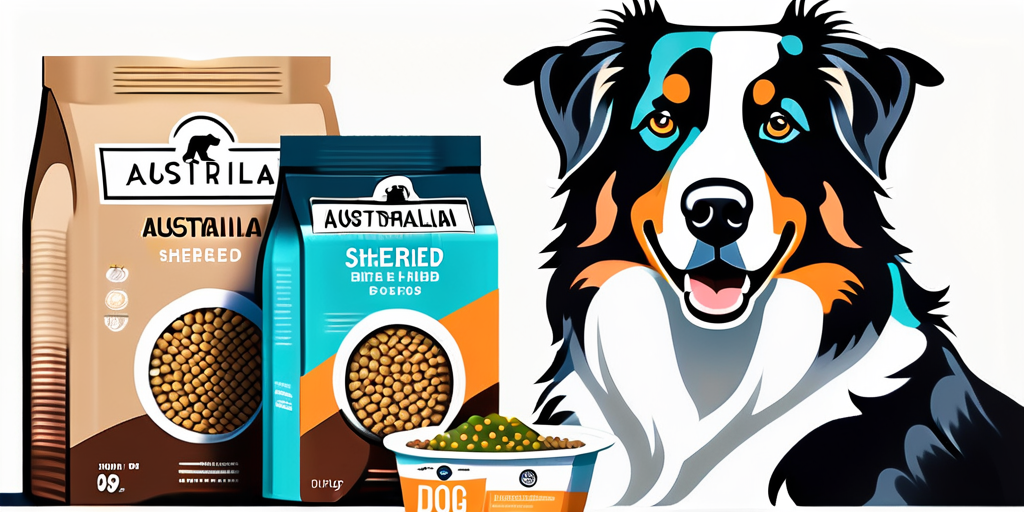Navigating the world of dog food can be a challenging task, especially when your furry friend has a sensitive stomach. Australian Shepherds, known for their intelligence and high energy levels, require a balanced diet to maintain their health. However, if your Australian Shepherd has a sensitive stomach, choosing the right food becomes even more critical. This guide will help you understand the dietary needs of an Australian Shepherd with a sensitive stomach and how to select the best food for them.
Understanding Your Australian Shepherd’s Dietary Needs
Australian Shepherds are active and energetic dogs that require a diet rich in proteins and carbohydrates to fuel their energy levels. However, if your dog has a sensitive stomach, certain types of food may cause digestive issues. Understanding your dog’s dietary needs is the first step towards finding the right food.

Protein is a crucial component of a dog’s diet, especially for active breeds like the Australian Shepherd. It helps in muscle development and maintenance. However, the source of protein matters. Some dogs may have difficulty digesting certain types of protein, which can lead to stomach sensitivity.
Carbohydrates provide the energy your dog needs for their daily activities. However, not all carbohydrates are created equal. Some are easier to digest than others, and choosing the right type can make a significant difference for a dog with a sensitive stomach.
Fats are also an essential part of a dog’s diet, providing additional energy and helping with the absorption of certain vitamins. However, too much fat can lead to pancreatitis, a condition that Australian Shepherds are prone to.
Identifying Food Sensitivities
Before you can select the right food for your Australian Shepherd with a sensitive stomach, you need to identify what is causing the sensitivity. This can be a challenging task, as food sensitivities can manifest in various ways and can be caused by a wide range of ingredients.
Common signs of food sensitivities in dogs include vomiting, diarrhea, excessive gas, and changes in appetite or weight. If you notice any of these symptoms in your dog, it may be due to a food sensitivity.
Identifying the specific ingredient causing the sensitivity can be done through an elimination diet. This involves feeding your dog a simple diet of foods that they have never eaten before, and then gradually reintroducing other foods to see which ones cause a reaction.
It’s important to note that this process should be done under the supervision of a veterinarian, as it can be challenging and time-consuming. Additionally, some dogs may have sensitivities to more than one type of food, making the process even more complex.
Choosing the Right Dog Food
Once you’ve identified your Australian Shepherd’s dietary needs and potential food sensitivities, you can begin the process of selecting the right dog food. Here are some steps to guide you:

- Check the Ingredients: Always read the ingredients list on the dog food packaging. Look for high-quality sources of protein, such as chicken, beef, or fish. Avoid foods with fillers, artificial colors, flavors, or preservatives, as these can often cause stomach issues.
- Consider the Nutritional Balance: The food should have a good balance of proteins, carbohydrates, and fats. Too much of one nutrient can lead to health issues. For instance, a diet high in fat can lead to pancreatitis in Australian Shepherds.
- Choose Easily Digestible Foods: Some foods are easier for dogs to digest than others. For instance, rice and oatmeal are carbohydrates that are often easier for dogs with sensitive stomachs to digest.
- Consider Specialized Dog Foods: Some brands offer dog food specifically designed for dogs with sensitive stomachs. These foods often contain easily digestible ingredients and are free from common allergens.
Transitioning to the New Food
Once you’ve selected a new food for your Australian Shepherd, it’s important to transition them slowly to avoid further upsetting their stomach. Here are some steps to follow:
- Start Small: Begin by mixing a small amount of the new food with your dog’s current food. Gradually increase the amount of new food while decreasing the amount of the old food over a period of a week or two.
- Monitor Your Dog: Keep a close eye on your dog during the transition period. If you notice any signs of stomach upset or other adverse reactions, it may be necessary to try a different food.
- Consult Your Vet: If you’re having trouble finding a food that your dog can tolerate, or if your dog’s symptoms continue despite the diet change, it’s important to consult your vet. They can provide further guidance and may be able to recommend a therapeutic diet.
Conclusion
Finding the right food for an Australian Shepherd with a sensitive stomach can be a daunting task, but with patience and careful observation, it can be done. Remember, every dog is unique, and what works for one dog may not work for another. Always consult with your vet before making significant changes to your dog’s diet.
By understanding your Australian Shepherd’s dietary needs, identifying potential food sensitivities, and choosing a high-quality, easily digestible food, you can help ensure your dog’s long-term health and happiness.
Join the BreedRead Community
For more expert advice on caring for an Australian Shepherd with a sensitive stomach, and to stay informed about the best practices in canine nutrition and health, subscribe to the BreedRead free newsletter. At BreedRead.com, we’re dedicated to providing you with comprehensive, breed-specific information that will help you make the best choices for your furry companion’s well-being. Don’t miss out on our tailored owner guides and in-depth insights—join our community today and take the first step towards a happier, healthier life with your dog.

